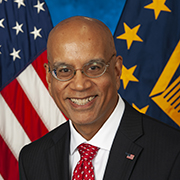Speakers
3 speakers
Date & Time
Jun 10, 2021 2:00 p.m. ET
Webinar
Date: On-Demand
Duration: 1 hour 30 minutes
Cost: No Fee
As the Veterans Affairs Department moves closer to completing its 12-week review of its electronic health record initiative that Secretary Denis McDonough initiated in March, it’s clear data will drive the path forward.
At same time, data isn’t just the underlying influencer, it’s also one of the eight review tracks. VA’s chief data officer Kshemendra Paul is working closely with the Veterans Health Administration, the Office of Electronic Health Record Modernization, the Office of Information and Technology and many others on data management review.
“A big challenge here is looking at data management, making sure that the semantics, meaning of data, is consistent and managed across that process. Cerner has been doing that on the migration path, and it’s a shared responsibility on the syndication path [coming back to VA] and a key thing that in partnership with the different players I’ve talked about. We’ve been actively working to develop and improve those capabilities. That’s a kind of a key focus,” said Paul on Ask the CIO sponsored by Commvault. “A second key focus of this activity is around how do we use this data to generate value for veterans and innovations on their behalf? A big part of why we’re moving from VISTA to Cerner, and the modernization activity is to take advantage of a more robust data model within the Cerner product, the analytics solution, to be able to do population level analytics to integrate what’s called social determinants of health type data, which we have a lot of VA meaning things like socio economic, demographic attributes, and to be able to create clinical reminders, clinical analytics, clinical decision support, to improve outcomes and change care delivery in terms of prompting clinicians or prompting veterans. Developing those frameworks and developing that process with our partners is a key focus of activity now.”
Paul said as the electronic health record workflows improve and become more stable, VA wants to use data to make improvements in care delivery and access and equity in outcomes. But before they can do that, standardizing the underlying data models is important.
“There are opportunities to look at this through the lens of those authorities [in the Evidence Based Policymaking Act and other laws] jointly with our partners and DoD and with an eye always on how do we optimize outcomes and access experience for the veteran, how are we able to strengthen what we’re doing?” Paul said. “Data is at the centerpiece, and it’s by managing data as a strategic asset is how we get the value.”
Getting more value out of its data has long been a goal at VA. But only in the last few years, and especially since Paul joined VA as its director for data governance and analytics in the Office of Enterprise Integration, has the focus intensified.
VA released its new data strategy in January outlining five goals:
- Stewardship
- Analytics
- Technology
- People
- Governance
Paul said at the core of the strategy is the ability to manage and integrate that data to put it to work on behalf of veterans, their families, their survivors and their caregivers.
“VA is a learning organization and that means using that data at every echelon across all of our programs. We want to have that consistent authoritative view with reliable trusted indicators to support operational decision making for benefits administrators, for clinicians, for hospital administrators for executives in the central office,” he said. “We also want to be able to support analytics and evidence building to support evidence-based policymaking and budgeting. Now, a few key ideas around the data strategy. One is VA has made a lot of progress in the area of veterans experience, customer experience. We’re a leader in that across the federal space. A key part of our data strategy is working hand in glove with the Department of Defense to take look at that journey, starting as a service member transitioning to be a veteran right across their life, and to be able to manage the data as effectively together as we can to be able to do join analytics so we can drive aligned policymaking.”
Each of the strategy’s priority areas try to address policy, sharing and analytic opportunities and challenges across all parts of VA.
Paul said the overall goal is to ensure data is relevant to the enterprise and the organization matures in how it collects, analyzes and uses information.
“That’s a long, difficult challenge, but it’s exactly the kind of thing we need to do to be able to integrate the data and meet the vision of driving better access and outcomes for our veterans, families, survivors and caregivers,” he said.
One example of how VA already is driving decisions and better outcomes is through its Million Veteran Program. Paul said it’s using longitudinal clinical information on veterans that choose VA and combining it with survey data, socio-economic, demographic data and genetic data to drive innovation.
“The value that we are kind of focusing on with the data strategy is looking at opportunities to take these core innovations that are major in their own right, but be able to scale them up to the enterprise level,” he said.
Paul said through his office the tools developed and used by programs like the Million Veterans Program can be share more broadly across VA.
The Office of Enterprise Integration that Paul leads isn’t located in the chief information officer’s office but works closely with the office.
“I run the corporate data analytics function, the National Center for Veterans Analysis and Statistics. We do predictive analytics, like the veteran population projections. We have some other predictive analytics data assessments. We do descriptive statistics across the 19.2 million living veterans. We do data governance and we also, in partnership with our colleagues in IT, are responsible for the department’s information architecture,” he said. “I am the co-chairman of the data governance council with a partner in the Office of Information and Technology. Most of the federal CIOs at the large departments are dual-hatted or their CDO works for the CIO. So that offers some challenges because there is adjacency and overlap and CIO and CDO authorities. For VA, it also offers opportunities for synergy and mission focus.”
The partnership between the CDO and CIO offices also is trying to break down traditional data siloes.
Paul said the biggest challenges is breaking down the cultural and sharing challenges between VA and DoD. But there also are internal VA barriers that need to be removed.
“We have a vision for a target state architecture and a capability inventory that will help us understand how to think about use cases. We can understand a methodology around analytics and business intelligence focused on high value requirements or what we term internally key analytic questions that we, in turn, map back to data resources, and are able to then bring those together data to answer questions,” he said. “We’re working on a data and analytics segment architecture within our enterprise architecture. We’re trying to identify the myriad investments related to analytics, business intelligence, data management and others areas, and we’re trying to tie those to specific technology choices sometimes referred to as a technology reference model (TRM). We’re also trying to tie it toward the future state of technology, architecture and capability taxonomies. Then we are also looking at our different use cases from a thematic high level perspective, and segmenting those down so we can start to think about what capabilities and which investments we want to really focus against those capabilities, and then look at it in terms of what use cases then those targeting capabilities are going to support.”
Paul said another key piece of technology to connect data and analytics is the use of application programming interfaces (APIs) and the creation of a data catalog.
The catalog and APIs will be important to ensure the disparate data is brought together over the long run.
“You have some sense of its quality or fitness for use and be able to quantify which uses are possible. So we’re focused also on interoperability at the metadata level,” he said. “As we work in the analytic space, we are developing guidelines for how to think about intellectual property that we create and ensure that we understand costs and avoid vendor lock-in. We’re never going to have all of our data on one system so it becomes a question of how do you understand and manage your data in a way that uses a platform, where you can move to another platform if necessary and have that degree of flexibility that is needed.”
Listen to the additional industry analysis:
Complimentary Registration
Please register using the form on this page or call (202) 274-4830.
How to access the content: Please note, you may need to re-enter your registration information if you previously registered for this webinar and returned to page after clearing your cookies or using a private browser.
This program is sponsored by 
Speakers

Kshemendra Paul
Chief Data Officer, Department of Veterans Affairs

Richard Breakiron
Senior Director, Strategic Initiatives, Federal, Commvault

Jason Miller
Executive Editor, Federal News Network
Please register using the form on this page.
Have questions or need help? Visit our Q&A page for answers to common questions or to reach a member of our team.
